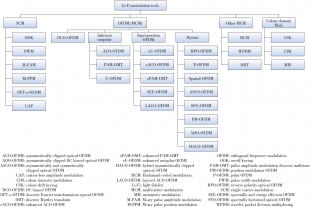The paper can be downloaded here
Modulation techniques for light fidelity (LiFi) are reviewed in this paper. LiFi is cellular wireless networking (re)using lights. Specifically, light emitting diodes (LEDs) are used in LiFi as visible light transmitters. This means future lighting systems fulfil two functions: high speed wireless networking and illumination. LiFi supports multiuser access and handover to enable mobile services. Since LED lights emit incoherent light only intensity modulation and direct detection can be used. Single carrier modulation techniques are straightforward to implement, but for data rates higher than about 15 Mbps computationally complex equalization techniques are required in frequency selective LiFi channels. Moreover, single carrier techniques suffer from DC wander effects. Alternatively, multicarrier modulation techniques offer a viable solution for high speed LiFi in terms of power efficiency, spectral efficiency and computational efficiency. In particular, orthogonal frequency division multiplexing (OFDM) based modulation techniques offer a practical solution as they are based on fast Fourier transformations for which very computational effective digital signal processing implementations exist. LiFi modulation techniques need to also satisfy illumination requirements. Flickering avoidance and dimming control are considered in the variant modulation techniques presented. This paper surveys the suitable modulation techniques for LiFi including those which explore time, frequency and colour domains.


